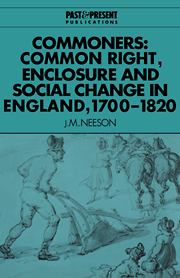Book contents
Introduction
Published online by Cambridge University Press: 01 February 2010
Summary
No Shire within this Land hath so little waste grounds, for theare is not in manner anie parte thereof but is turned to some profitable use.
John Norden, Speculi Britanniae pars Altera; or a Delineation of Northamptonshire; being a brief historicall and choriographicall description of that Country … by the travayle of J. Norden, in the year 1610(1120), p. 20.‘The interest which a commoner has in a common is, in the legal phrase, to eat the grass with the mouths of his cattle, or to take such other produce of the soil as he may be entitled to …’ The soil itself, the land, was not the commoner's, but the use of it was. That use, what the law called a profit à prendre, was common right. Its history had important consequences for small landholders, rural artisans and landless labourers in eighteenth-century England. Their relative independence of wages and markets, the changing levels of their wages and poor relief, the shifting components of their family incomes, the histories of their trades and manufactures, the balance of power in their villages, their very sense of who they were and how well they lived were all in part dependent on its survival or decline.
- Type
- Chapter
- Information
- CommonersCommon Right, Enclosure and Social Change in England, 1700–1820, pp. 1 - 14Publisher: Cambridge University PressPrint publication year: 1993

